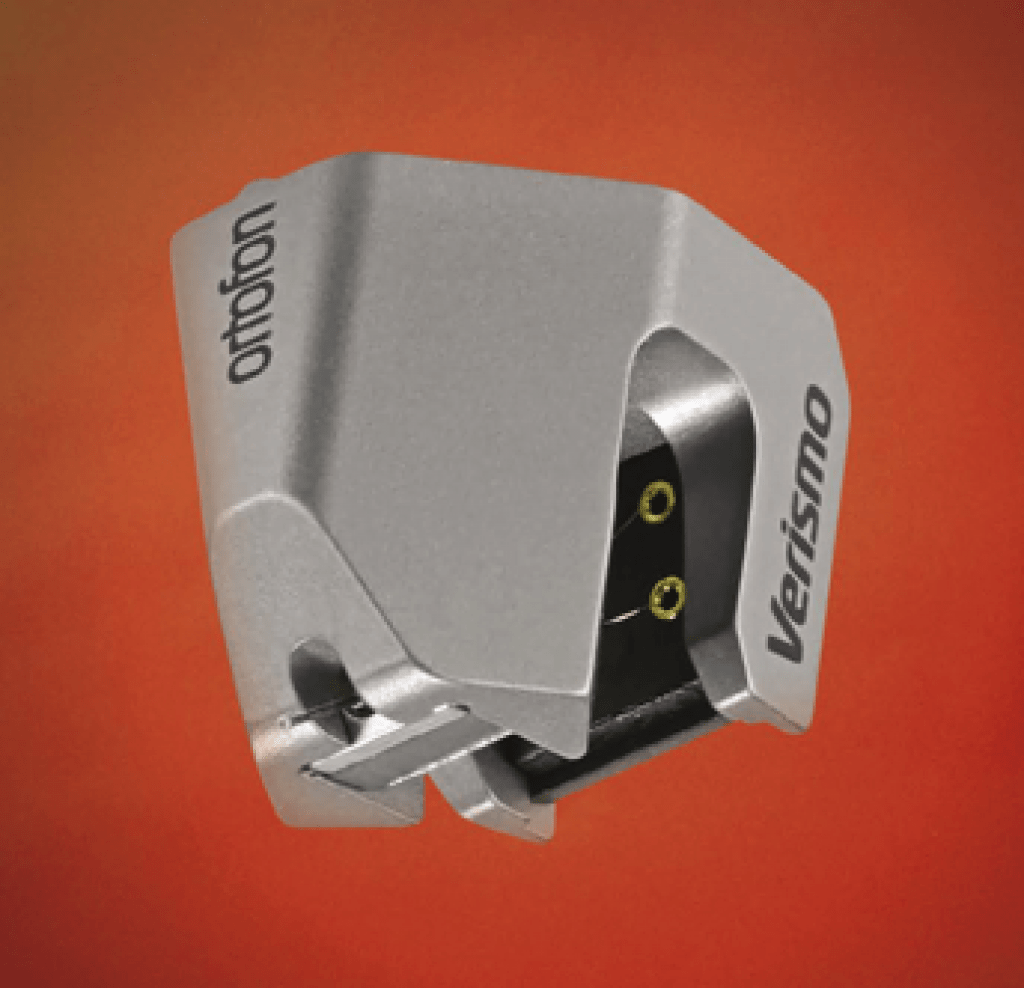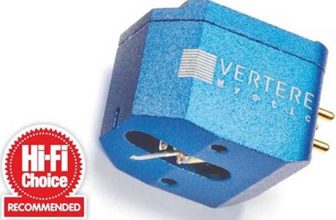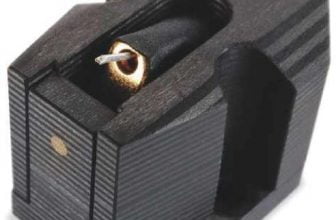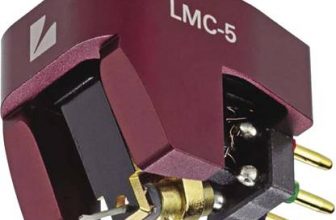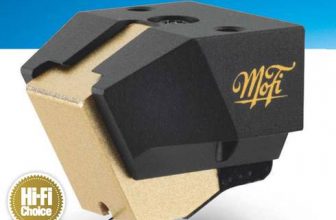ORTOFON VERISMO Review – Pure Diamond
With a pure diamond connection to LP, Ortofon’s new Verismo cartridge has a unique sound says Noel Keywood. Read our ORTOFON VERISMO Review.
Listen to the cantilever. Every cartridge has one and the music passes through it, gaining flavour on the way. At the quality level I’m talking about here, it’s a major issue. That’s why Ortofon have given their new Verismo moving coil cartridge a diamond cantilever, with a diamond stylus bonded to the end. Yes, we’re talking all-diamond here, if not slivers of the Koh-i-Noor. Instead, CVD industrial diamond – but it still doesn’t come cheap, the Verismo carrying a lofty £ price tag.
With vinyl becoming a contested market once again, sales rising steadily, there’s an audience prepared to consider buying a cartridge this specialised and expensive, especially as a diamond rod is stronger than a fine alloy tube so the Verismo isn’t super-delicate, as high-end cartridges were in the past.
But Verismo isn’t the same as the many other Ortofons that have passed through my hands either, from the A95 to the Cadenza Bronze I use regularly and sonically favour (to Ortofon’s bemusement). But then pickup cartridges can become quite distinctive in their sound, especially when they use exotic materials – as I was to find here.
The Verismo has a skeletal body built from sintered titanium by a Selective Layer Melting (SLM) technique, as in the A95.This puts three ridges on top for contact with the head shell, in a form of three-point fixing.There are two threaded screw holes and four sets of fixing screws Ortofon
say, most likely brass (our review sample came with none). Although the body looks light, it’s weighty at 9.5gm – 10gm being the upper limit for many arms.That makes it as weighty as the Cadenza series if not as massive as the MC Anna Diamond (also with diamond cantilever) that comes in at a whopping 16gm.
That the Anna Diamond is their “highest performing” MC cartridge Ortofon say, suggests the Verismo is a more conventional variant better aligned to everyday expectations. Apart from having broader arm compatibility due to its lower weight, it also has higher quoted compliance than the Anna, yet it has a slightly higher quoted tracking force of 2.6gm optimum, with 2.8gm quoted as maximum – one of the highest down force values of any Ortofon cartridge. In use it needs all of 2.6gm I found and 2.8gm makes it less skittish when hand cueing as
I do. It also improved tracking which otherwise is inferior in the mid-band to the Cadenzas and even 2M Series moving magnet types.
Which brings me to the important issue of tip mass, that has to be kept low for good tracking of vocals and high frequencies, such as Shure’s orchestral bells on their TTR series test records. As lovely as the material properties of diamond might appear it is denser than both boron and aluminium and I cannot help but wonder whether this comes into play with the Verismo, explaining why its midband tracking doesn’t match that of other cartridges, especially those with boron rod cantilevers, including those made by Ortofon.
I’ll say straight away that I’m no fan of boron rod cantilevers, finding them sterile sounding at best, but they do track, that’s for sure – and give flat frequency response. In other words, they are the answer to a maiden’s prayer, but I’m no maiden – so not my prayers.
To keep tip mass down the signal coil needs to be small, needing fine wire and few turns. The Verismo uses gold plated high purity copper windings, with a quoted electrical resistance of 6 Ohms. Curiously, Ortofon suggest a load of 10 Ohms as ideal – a very low value. The usual rule of thumb is x10 for a load to avoid voltage loss, meaning 60 Ohms, a rule they use for the Cadenzas, but not the Verismo. So there’s a reason, unstated in their literature. It would work for power transfer into a step-up transformer and since output is very low this might be the thinking, Ortofon producing a small range of such transformers. Like me they prefer the sound of a transformer to transistor preamp, so bear this in mind. This persuaded me to use our Icon Audio PS3 valve phono stage with input transformer, in addition to our Pro-Ject Phono Box RS2 that can be dialled down to 10 Ohms input resistance – no coincidence since Pro-Ject work closely with Ortofon.They later told me that in fact the spec was missing a > (greater than) sign – simple as that! No matter, step-up transformers are still preferable I found.
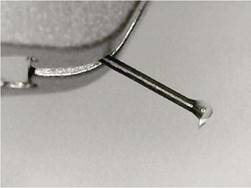
The diamond cantilever with diamond stylus bonded direct at 90 degrees.
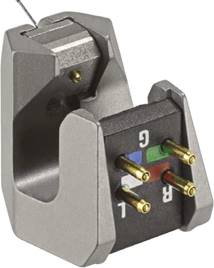
Rear connection plate carries colour coded gold plated pins. The Grounds are isolated from each other and the metal body, to suit balanced connection.
To the diamond cantilever Ortofon bond a nude Replicant diamond stylus with rectangular shank for accurate orientation of the long contact tip. Minor radius is 5 muym and major radius 100 muym.
Of stylus and cantilever they told me “The diamond is CVD diamond, which is 100% the same as natural diamond. But the CVD diamond corresponds to the absolute best natural diamond grade (Type Ila ) due to the absolute purity. Also it is 100% uniform.We use this CVD diamond for the styli in many of our cartridges. It is not fragile, with no more returns than with boron. Cantilever replacement comes in at €3000”.
SOUND QUALITY
The Verismo was installed into our SME309 arm on Timestep Evo modified Technics SL-1210 Mk2 turntable. After measurement and running-in usage I settled on 2.8gm downforce. Initially, our Pro-Ject Phono Box RS2 phono stage was employed, connected up via balanced input from the SME, with balanced output taken to our Creek Voyage i20 amplifier, feeding Martin Logan ESL-X electrostatic loudspeakers. But I moved on to our Icon Audio PS3 Mkll valve phono stage (with input transformers) feeding a PrimaLuna EVO 300 Hybrid amplifier, since this combo worked better all round.
With Phono Box RS2 set to 10 Ohms the Verismo was, as expected from previous experience with a diamond cantilever cartridge, crystal clear, fast and deeply detailed. Every LP I played had a bright white light shone on it, most revealing being Hugh Masekela’s Uptownship, from Hope, where his trumpet was more vivid than I have ever heard before. Where boron cantilevers are sterile to being ho-hum, the Verismo’s diamond absolutely threw trumpet at me, doubtless helped by its strength of output at higher frequencies. Being a fan of a fuller, more rounded sound with greater timbral resolution I was deeply impressed but not altogether wowed.
Spinning old discs like Fleetwood Mac’s Rumours showed the stylus was mining information that I’d never heard before and wasn’t too edgy with old vinyl, but Mick Fleetwood had popped out for a sandwich it seemed; the patina was a light one.Turning input resistance up to 100 Ohms brought up level and opened the sound up slightly, making the stage usefully more expansive; I heard no merit in a 10 Ohm setting.
Up-ending our long-suffering turntable and plugging in an SME unbalanced arm cable allowed connection to the input transformers of the PS3 and this changed the presentation substantially, bringing in a whole layer of depth and timbral resolution, whilst not negating the sense of extreme speed and impact to the layered percussion work in Uptownship. It could have been that this was the cartridge and preamp balancing out in a tonal sense, but I suspect there was something more fundamental going on as I use the RS2 a lot and it’s not bright. The Verismo benefits from being used with transformers it seems from this comparison.
With the PS3 Ortofon’s Verismo delivered what was undeniably the fastest and most insightful sound I have ever heard, having a sense of crystalline clarity boron lacks. Mark Knopfler’s guitar work in True Love Will Never Fade, from Kill To Get Crimson, was shimmeringly detailed and precise, each and every plucked string ringing out with a sense of sweetness as to be almost honeyed. For the most obvious and delightful harmonic decays this cartridge has no peers. Diamond shades aluminium and boron in obvious fashion: I got to hear it all. The stage lights are turned up to maximum; no romantic shadows hide unnoticed details in the groove.
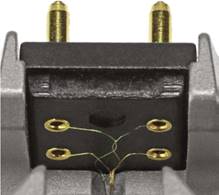
Fine wire leadouts are soldered into the rear pins. They are exposed and should not be touched.
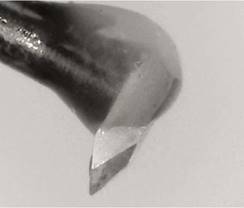
The square shank of the bonded diamond stylus aids axial orientation. Although tilted relative to the LP surface, the Replicant grind gives a side contact face upright to the groove.
The drama of 12in 45rpm singles was heightened, the repetitive synth kick-drum beat on Alison Goldfrapp’s Ride A White Horse taking on strong outline backed by brute power, as this track shook the room. I ploughed through many 12in 45s to check out tracking, since these are relatively hot cuts, and the cartridge remained secure in the groove.
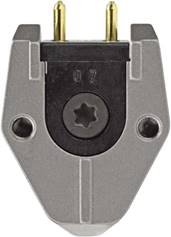
At top the three support ridges that raise body off headshell. Fixing screw holes are tapped and blind.
With classical there was a bright hue to the strings of the Trondheim Soloists playing Mozart violin concertos, but they sat in spacious surroundings. Marianne Thorsen’s violin was sheeny, but highly detailed. But then this DXD digital transcription onto vinyl does have a sheen to it and the PrimaLuna EVO 300 Hybrid helped make it obvious.
Spinning Shure’s Era IV tracking test disc (TTR115),Verismo took fright and jumped out of the groove on Level 4 of the Harp and Flute test (Side Two), with another level to go – a mediocre performance. Level 3 is as high as commercial LPs are likely to go, Levels 4 and 5 being torture tracks, so it’s satisfactory, but with little leeway. In ordinary use I did not hear it mistrack, but Era IV showed that it will jump out of the groove if the going gets tough, as other test discs had suggested.
CONCLUSION
This cartridge gets more from the groove of an LP than any other I’ve heard – delivering it in dramatic fashion. For insight and sonic speed it has no rivals. Tracking is not stellar even at 2.8gm downforce and it needs the help of input transformers to sound sonically balanced I found, but such tunings are to be expected at this level of specialisation. Not a soft or warm sound, but vivid beyond belief. Anyone looking for the ultimate in speed and revelation must hear the Verismo: it has extraordinary sound quality.
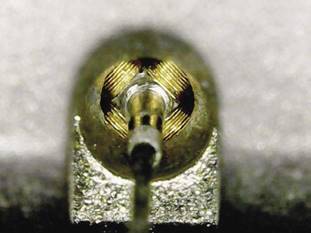
Signal coils at top of the cantilever. A sheath accepts the diamond rod.
MEASURED PERFORMANCE
Frequency response of the Verismo measured almost ruler flat to 20kHz our analysis shows (JVC TRS-1007 test disc). On inner grooves (red trace) there is a slight fall in high frequency output, due to stylus tracing loss. With output flat to 12kHz this won’t be readily apparent, but the amount of loss is slightly greater than other Ortofon cartridges, which is odd.
Tracking of 300Hz test tones on CBS STR-112 test disc was secure up to the 80 muym peak amplitude quoted, with Ortofon’s 2.6gm quoted optimum down force.
At 1kHz (B&K2010 test disc) where acceleration is higher and tip mass more influential, 18cms/sec was cleared, with slightly mistracking at 20cms/sec, a mediocre result for a quality MC, Ortofon’s other cartridges managing better at lower downforce.
Distortion was as expected, measuring 1.2% on lateral modulation. On vertical modulation the figure was a reasonable 3.6% due to a measured vertical tracking angle of 29 degrees (DIN 45-452 test disc). Optimal is 22 degrees.
Output was low, measuring 0.18mV at 3.45cm/sec, making a quiet preamp or step-up transformer necessary.
The Verismo did not measure as well as Ortofon’s less expensive moving coil cartridges such as the Cadenzas. Results were satisfactory all the same, with notably smooth frequency response right up to 20kHz. NK
